Articles
Viking Pop Culture on Display:
The Case of the Horned Helmets
Abstract
The travelling exhibition, Vikings: The North Atlantic Saga, featured a case containing primarily plastic horned helmets seamlessly included within a serious cultural exhibition. Never worn by Vikings, this popular culture icon embodies the disjuncture between scholarly and popular knowledge of the Viking past. The exhibition as a whole sought to highlight the recent studies that have revealed a complex view of the Viking past at odds with the simplistic popular stereotype, and the homed helmet case was a fitting introduction to this theme. But it simultaneously demonstrated the lack of agency museums have over the meanings associated with modern popular culture items and was therefore an ironic, somewhat problematic, experience for the visitor. This essay examines issues that arose during the curation, design, and display of this case, suggesting an accepted, though perhaps unjustified, categorical division between popular material culture and "authentic" artifacts.
Résumé
L'exposition itinérante Vikings: The North Atlantic Saga comprenait une vitrine abritant surtout des casques cornus en plastique, objets déconcertants dans une exposition culturelle sérieuse. Pourtant jamais porté par les Vikings, ce symbole populaire est une manifestation concrète de la différence entre la connaissance que donne l'érudition et la connaissance populaire du passé des Vikings. L'exposition dans son ensemble visait à mettre en lumière de récentes études qui avaient révélé une vision complexe du passé des Vikings, contredisant le stéréotype populaire simpliste des Vikings, et la vitrine aux casques cornus constituait une bonne introduction à ce thème. Mais celle-ci démontrait en même temps le fait que les musées n'ont aucune autorité sur les significations associées aux objets de la culture populaire. L'exposition a donc été une expérience ironique et un peu problématique pour les visiteurs. L'article traite de questions soulevées parles volets conservation, conception et exposition de cette vitrine, qui supposent une division catégorique acceptée mais peut-être pas justifiée entre culture matérielle populaire et objets façonnés « authentiques ».
1 In 1898, a Swedish farmer living near Kensington, Minnesota, was grubbing up trees to clear more land for crops. According to the published reports,1 as he toppled one poplar tree, he discovered clenched in its roots a large stone slab. Upon inspection, the stone turned out to have peculiar carvings, identified later as Scandinavian Runic letters. As transcribed, the letters tell the story of "8 Goths and 22 Norwegians" who came to North America in 1362 and were on an exploratory journey that brought them to modern day Minnesota. If true, this would provide proof of a European presence in North America almost 150 years before Columbus "sailed the ocean blue."
2 Current scholarly opinion is that the stone is a modern hoax, created most likely by Scandinavian American immigrants who populate this area of North America. Neither the forms of the runic letters nor the circumstances of the find inspire serious scholarly attention. However, despite the united front of professional academics, amateur enthusiasts throughout the Mid-west continue to push for a re-evaluation of the stone.2
3 The cliché of "talking past one another" hardly does justice to the serious social phenomena that the Kensington Stone controversy represents. All involved are educated, Caucasian, westernized individuals who would normally be considered members of the same culture group; but if culture implies a shared set of values, nothing could be further from the truth. Two disparate modes of thinking about what constitutes proof and two separate normalizing pressures — on the part of scholars to declare it a hoax and on the part of Scandinavian-Americans to staunchly support it — operate at odds with one another. There is in fact very little hope of a resolution, despite calls for a conference in which both sides would be equally represented.
4 The Kensington Stone is a very specific and local issue where the origin of the discrepancy and the points of difference can be well defined. Through it we see a narrow case of a much broader phenomena: the disjuncture between scholarly and popular thought. In a touring exhibition, Vikings: The North Atlantic Saga, I and the rest of the creative team had to grapple with divergent conceptions of the term Viking, one created through the medium of modern popular culture — including of course television and print media, but also material culture items like plastic horned helmets — and one created by scholars conducting ongoing research into the topic. We attempted to address the opposing nature of these two conceptions in a section of the exhibition entitled "Recapturing the Past," which included one case of Viking popular culture items: the case of the horned helmets. Visitor response to this case was disproportionately high. In this review of that case and the role it played in the exhibition, a number of assumptions regarding museums, exhibits, and popular material culture will be examined.
The Viking Stereotype
5 While defining a stereotype seems a somewhat ridiculous endeavor, one working definition of the Viking stereotype is that it revolves around an image of a barbaric, uncontrollable, dirty, male warrior. This stereotype has evolved over time and place in diverse ways.
6 The mainland European view of the Vikings finds its origin in medieval documents that testify to the widespread destruction caused by Scandinavian raiders during the Viking Age, which began in A.D. 793 with the raid on Lindisfame Monastery and ended with the defeat of the last Norwegian invasion fleet by England in A.D. 1066.3 The accounts of the myriad invasions that took place throughout England, France, the Netherlands, and even one excursion into the Mediterranean, were written by the horrified Christian monks on the losing side of the battle. These documents are now seen as propagandized, one-sided statements through a more critical historiography, but for centuries their descriptions of the barbaric actions of the Vikings were taken at face value, which led to a pervasive acceptance in Europe of the negative Viking stereotype. No one disputes that Viking raids did indeed take place, but the more complex economic and social explanations for the raids offered today have not yet become part of the popular European conception of the Vikings.4
7 In Scandinavia, the stereotype of the Viking is not one of a feared enemy but of a beloved ancestor who is still close in the heart and minds of many. Part of this enthusiasm rests on the pivotal role the Viking Age (750-1050 A.D.) played in the development of Scandinavian history. Before the Viking Age, the people of the Scandinavian peninsula were isolated tribes engaged primarily in internecine battles, although with impressive trade contacts; but by the end of the Viking Age they were active participants in the wider European arena. Over this three hundred year period, the first royal lines in each of the three Scandinavian kingdoms became established as the nascent kingdoms formed, somewhat in emulation of the European model, and Christianity replaced — often at the violent insistence of the newly powerful kings — the traditional pagan religion of the Vikings and their ancestors.5 Because each of the medieval Scandinavian Kingdoms — Denmark, Norway, and Sweden — find their origin in the Viking Age, it is easy to understand how "the Viking" has attained a central place in the Scandinavian conception of self. But the stereotype is more complicated than simply thinking of Vikings as the "fathers" of the Scandinavian countries. Nationalistic Scandinavians can boast — with only a bit of an exaggeration — that their Viking ancestors controlled great trade networks and vested mighty armies (Fig. 1). The wealth and power obvious in several opulent burials excavated in the late nineteenth and early twentieth centuries6 and the tremendous range of activity — from the Byzantine Empire to the shores of North America — described in the sagas and other works of literature all contributed to a conception of the Vikings as worthy to be emulated and greatly esteemed. Lauded as sophisticated poets and talented artists who worshiped powerful gods, the Vikings were especially embraced by Scandinavians in the nineteenth century.7 They continue to be the cornerstone of museum exhibits in Scandinavia.8 The modern Scandinavian stereotype of the heroic Viking is primarily a nationalistic statement about the historic independence and uniqueness of Scandinavia.
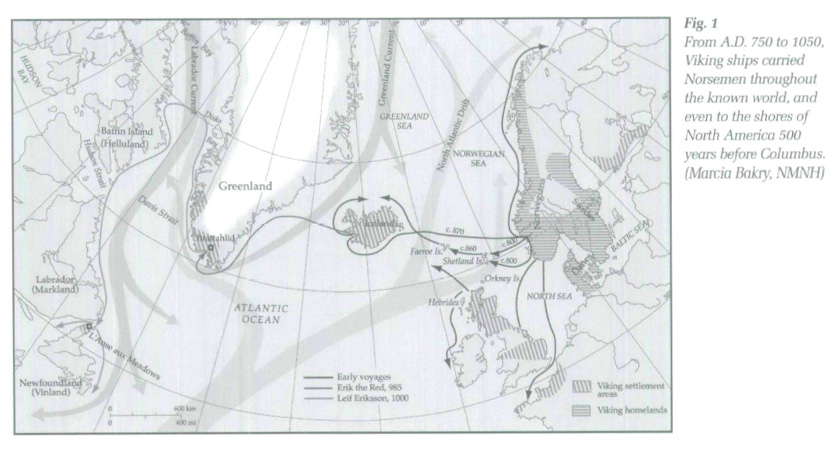 Display large image of Figure 1
Display large image of Figure 18 Scandinavian immigration to North America took place primarily between 1850 and 1870,9 which was ironically also the period of heightened Scandinavian nationalism. The cultural complex imported to North America from Scandinavia included that nationalism, and with it the more positive Viking stereotype of Scandinavia. But in the one hundred years since immigration, the Scandinavian-American sense of their Viking ancestors has diverged from that of Scandinavia. Here the Vikings are taken as adventurous explorers, rather than paragons of a unique northern culture. The 1893 sailing of a replica Viking ship from Norway to the Columbian World Exposition in Chicago (intended to celebrate the 400-year anniversary of Columbus in the New World) was likely the origin of this conception, since it was a brilliant public relations campaign championing the saga accounts of Leif Eriksson's voyage to North America 500 years before Columbus (Fig. 2). Today, one of the more common items of Viking popular culture in North America are small models of Viking ships, and many Scandinavian-American businesses utilize a likeness of the 1893 ship as their company logos, thus solidifying the association between Vikings and exploration for Scandinavian-Americans.10
9 But for the broader North American population, the stereotype of the Vikings has evolved (or devolved) into something far broader. In a survey I conducted of a small sample of visitors to the museum, it was clear that the word Viking conjures up violent images of cavemen, barbarians, or crazed killers. Although most could not name specifics about the Vikings such as when or where they lived, they felt they knew what the word Viking meant because they were familiar with the stereotype. Stripped of any definite referent, the Vikings are simply representative of a bestial male type, completely at odds with civilized society. Utilizing a structuralist model, such a type exists only to highlight the exact opposite: the docile male who controls his anger, bathes regularly, and in all other ways is a perfect gentleman. We see the tension between the two in the comic strip "Hagar the Horrible"11 where a stereotypical brutish Viking male is asked to live within the domestic rules of his wife.
Viking Stereotype Takes Material Form
10 The Vikings have been a successful theme for popular material culture, especially in Scandinavia, France and the United States. The language of Viking popular culture relies primarily on the inclusion of horn-shaped appendages protruding from a cone-shaped helmet.12 But other common elements unite popular material culture items about the Vikings: males with bushy beards are most often depicted, and the items are often associated with male activities like shaving and sailing. This is the material manifestation of the stereotyped view of the Vikings.
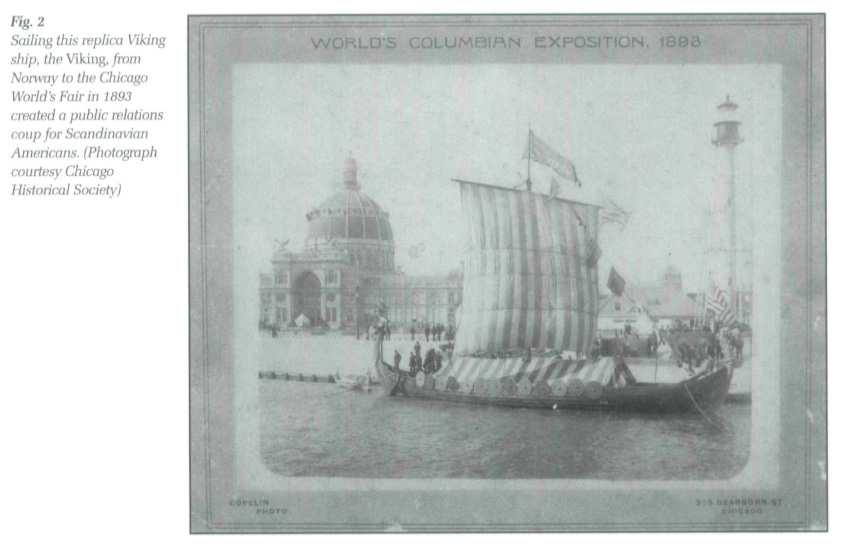 Display large image of Figure 2
Display large image of Figure 211 The horned-helmet icon seems to have its modern origins in the Wagnerian Ring Cycle opera, where the male chorus wore horned helmets, while the other characters wore winged helmets. Winged helmets were a classic Greco-Roman motif that had been adopted throughout Europe. But during the Romantic Nationalism movement of the nineteenth century, Northern Europe began to seek themes and design elements in opposition to the Southern European models,13 perhaps as a further codification of the break between the Catholic South and the Protestant North. So the Wagner costume designer was working within that process when he/she replaced wings with horns.
12 Why horns? Archaeological excavations of the nineteenth century have uncovered magnificent curving bronze horns, including two helmets with curved appendages on either side. Though most likely used for shamanistic rituals and not for war, bronze horns were understood to be of deep significance for prehistoric Nordic people in Denmark, Norway, and Sweden. Although we now know these Bronze Age horns predated the Viking Age by over 2000 years, such chronological distinctions were less well defined in the nineteenth century. In addition to providing an opposition to Southern Europe, and bespeaking great antiquity, the horned helmet also resonated on another level. Archaeological evidence suggested that silver decorated horns were used as drinking vessels during the Viking Age (Fig. 3). Symbolically, cups made of cow horns presumably intended for consuming alcohol neatly connected man with nature, a hallmark of the Romantic Nationalistic movement, implying a deep connection between the people and the land on which they lived.14
13 By resonating on all these levels, the horned helmet became a singularly appropriate manifestation of Scandinavian nationalism. Over the last two hundred years, Viking inspired material culture has continued to evolve in response to the changing political fortunes in Scandinavia. One particularly interesting manifestation is the troll doll wearing a horned helmet (Fig. 4). Since the publication of Norwegian folktales in the mid-nineteenth century,15 trolls have been a popular embodiment of Scandinavian nationalism. By adding a horned helmet to this mythical creature, the importance of the Vikings in Scandinavian nationalism is also acknowledged, although the reality of the Vikings as a people is certainly undermined. Tourist shops in Scandinavia are well stocked with troll dolls and horned-helmeted warriors.
14 The horned helmet has had at least as successful a career in North America as it has had in Scandinavia. One obvious source for the ubiquitous homed helmet is the Minnesota Vikings football team. Minnesota has a concentration of Scandinavian immigrants, and their descendants continue to actively promote their Scandinavian identity through festivals and traditional foods. But more importantly, they continue to exhibit pride in their Viking ancestors, just as most Scandinavians do (Fig. 5). For Scandinavian-Americans, the tales of Vikings crossing the North Atlantic 1000 years ago in open decked boats seems an especially fitting parallel to their own emigration. This may explain the appeal of the Kensington Stone: it suggests descendants of Vikings were probing deep into North America. not simply accidentally sailing to her shores.16 Thus when in 1961 Minnesota acquired rights to create a National Football League team, they chose the Vikings as their name and mascot. And they, of course, painted horns on the side of the helmet. With the tremendous popularity of NFL football as a staple of American culture, nearly every American associates Vikings with horned helmets.
15 The sale of plastic horned helmets, dolls wearing horned helmets, even beautiful pewter statues of horned-helmeted warriors, is so commonplace that our museum sales shop had trouble ordering Viking-related merchandise that did not have horned helmets.17 The marketing and production forces were squarely lined up behind the viability, and consumer appeal, of the horned helmet.
Current Research
16 All this despite repeated claims by archaeologists that Vikings, or Norsemen, did not wear horned helmets. The only complete (though not intact) Viking Age helmet from Scandinavia that has been excavated was a metal cap with a cat-eye shaped eye and nose guard, but certainly no horns (Fig. 6). The fact that Vikings did not wear horned helmets is the first of many stereotypical views that are directly at odds with current Viking scholarship. Excavations in trade sites in Sweden and the British Isles and of farm sites in the islands of the North Atlantic, analysis of environmental indicators, and new evaluations of literature written directly following the Viking Age have all contributed new ideas about who the Vikings were. Even the use of the term Viking is incorrect: technically, the culture name is Norse, and Vikings are simply one occupation which a Norseman could choose to follow.
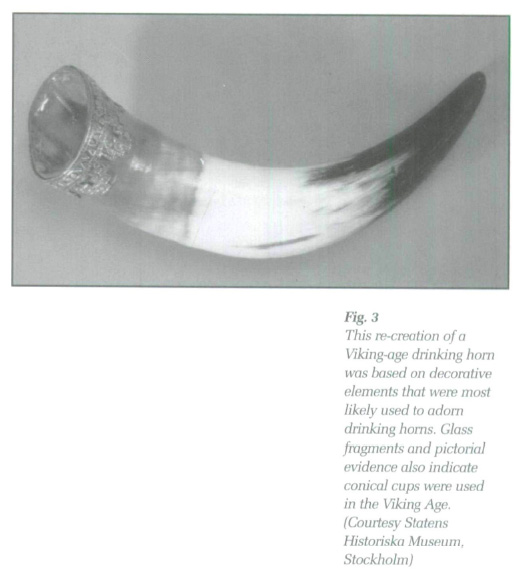 Display large image of Figure 3
Display large image of Figure 3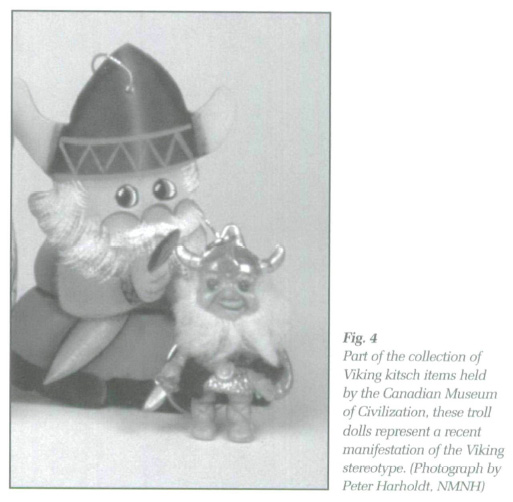 Display large image of Figure 4
Display large image of Figure 4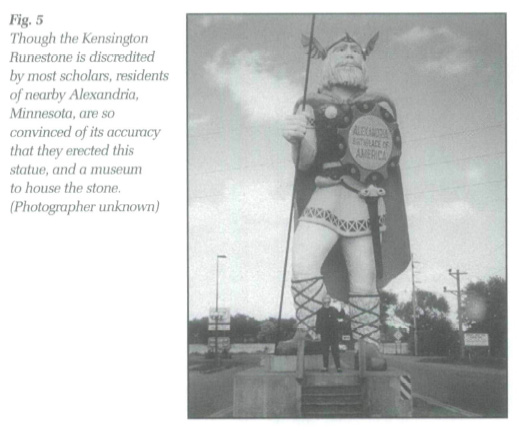 Display large image of Figure 5
Display large image of Figure 5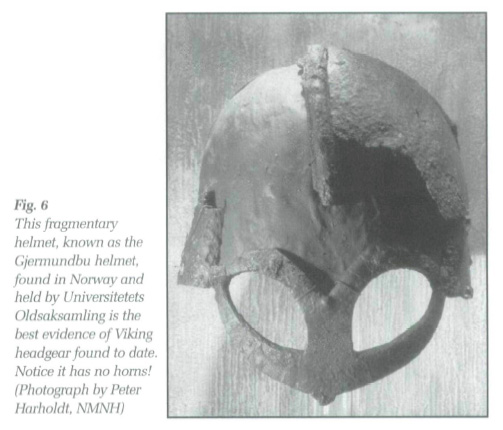 Display large image of Figure 6
Display large image of Figure 6The Exhibit
17 It was in an attempt to bridge this tremendous gulf that the Smithsonian's National Museum of Natural History began working on a special, travelling exhibition entitled Vikings: The North Atlantic Saga.18 The project was envisioned as a commemoration of a little known piece of history: the arrival of the Vikings in North America 1000 years ago. The exhibition opened in Washington in April 2000 and is currently touring the United States and Canada.19 Containing almost 400 objects borrowed from 29 institutions throughout Scandinavia, the U.K., Canada, and the United States, the exhibition is intended as a serious treatment of the new information scholars have uncovered about the Vikings in the last twenty years and to solidify in the national narrative that the Vikings did arrive in North America 1000 years ago.
18 As such, the main body of the exhibition follows the western expansion of the Vikings. Their life in the Scandinavian homelands of Denmark, Sweden, and Norway is exhibited through a series of cases: artifacts uncovered from major Viking trade sites highlight the many who were craftsmen and traders; jewellery and clothing demonstrates the social divisions between elites and commoners and between ethnic groups like the Saami and Finns; pagan and Christian religious items focus the visitor's attention on the process of the conversion to Christianity; and eating implements and iron manufactured tools illustrate daily life on the farm. All of these cases serve to demonstrate the complexity and richness of Viking Age Scandinavian culture (Fig. 7).
19 The next section launches the visitor into the North Atlantic. A video of ships at sea paired with a fibre optic map conveys the dramatic spread of the Vikings from Scandinavia beginning in 830, to the Faeroes by the 850s, to Iceland by 875, to Greenland by 985, and finally to North America by 1000 A.D. The American Museum of Natural History, the second venue for the exhibition, added a large-scale model of the type of ship used to cross the North Atlantic as a new component in this section.
20 The next three sections follow that geographic spread. In the "Taking the North Atlantic" section, artifacts from Iceland demonstrate how Vikings adapted to life in this treeless, iron-poor environment, but the focus of this section is the original saga manuscripts and an audio presentation of saga stories of voyages to "Vinland the Good." The exhibition's next section is on "Vinland" itself, showing the archaeological evidence of Vikings in North America and their contact with First Nation peoples. Here a large model of the only confirmed Viking site in North America, near the village of L'Anse aux Meadows in northern Newfoundland, is the visual anchor. The final section of the exhibition displays housewares and religious items from the Norse colonies in Greenland, which were established by Erik the Red in A.D. 985 and which flourished until the 1300s, but gradually died out by the mid 1400s. An infant's coffin and a young girl's burial dress, displayed in a simple case, convey this sad ending to the Vikings western expansion, and end the exhibition.
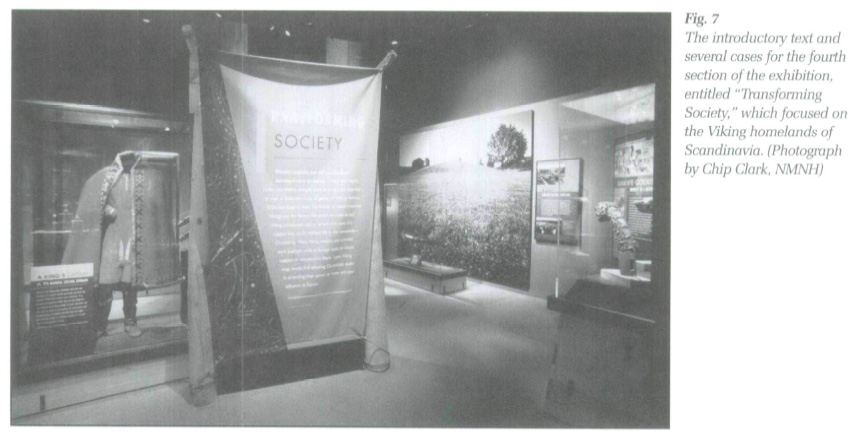 Display large image of Figure 7
Display large image of Figure 721 While these sections are the central curatorial content, our design team rightly wanted to begin the exhibition with some orientation material. The introductory section paired a time-line of the major events in North Atlantic history from A.D. 750 to the present and a large wooden map of the North Atlantic with select objects from throughout the region, including a cast of the Jelling Stone, a magnificent Viking Age monument from Denmark, and a smaller authentic Viking Age stone memorial marker from Gotland, Sweden. Our designers also encouraged us to create a separate section focusing on the Vikings as raiders, a topic which our curatorial team had not wanted to emphasize. A one-to-six scale model of a Viking ship, a large mural of the Viking raid on Lindisfarne monastery, a case of Viking weapons, and a case of magnificent items looted by Viking raiders (Fig. 8) was tempered by a discussion of the bias of historical records, a panel on the many Vikings who stayed to settle in the areas they raided, eventually integrating into the cultures of areas such as Normandy and Scotland, and a 3-D computerized animation demonstrating the sophisticated construction and agile operation of a Viking ship.
Confronting the Viking Stereotype
22 There was still one aspect of the Viking story that we wanted to include in the exhibition: the modern popular interest in the Vikings. Originally, this was planned as the final exhibition section, in keeping with the chronological order of the exhibition. But the exhibition team realized, given the pervasiveness of Viking stereotypes and our use of the term Viking in the tide of the exhibition,20 that such a placement would tacitly reinforce those ideas. We hoped that debunking those stereotypes early in the exhibition would encourage more visitor interest by demonstrating that perhaps they did not know as much about Vikings as they thought they did. Our exhibition was planned as a fairly text-heavy presentation, so it was critical to set up a rather didactic learning environment.
23 We therefore decided to create as the second section of the exhibition, following the introductory material, a room entitled "Recapturing the Past," which focuses on the reinterpretation of the Viking past that has occurred since the nineteenth century. This reorganization opened up the rhetorical possibility to make the discussion of the modern interest in the Vikings far more than a post-script. Rather it became an ideal locale to directly address those stereotypes, which we hoped to demonstrate were an outgrowth of ideas over 100 years old. (And with a demonstration of their "archaic" origin, to instantly undermine their credibility in a very modernist statement of the evolution of ideas.)
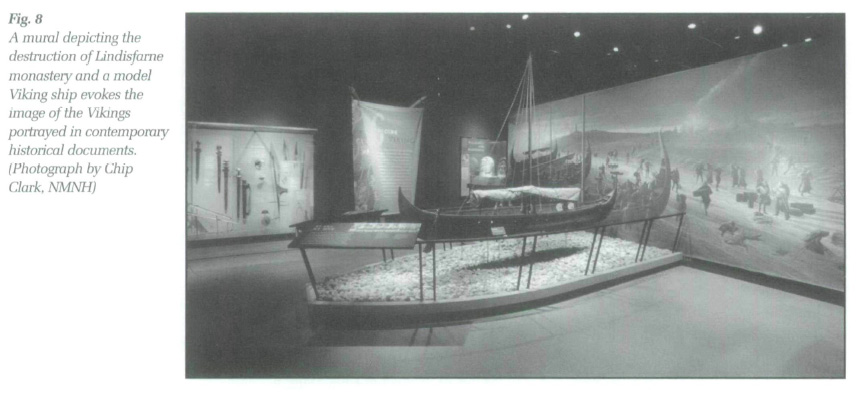 Display large image of Figure 8
Display large image of Figure 824 The main text, printed on both sides of a thick canvas, is illustrated by a famous Norwegian painting from the nineteenth century entitled Thor Battles the Giants,21 which sets the tone for the romantic and overblown view of the Vikings explained in the room. In the Washington installation, this hung over the central case in the section: a re-created archaeological excavation of a mass burial. Utilizing a combination of authentic and replica bones, this visually impressive case shows the remains of thirteen males, either Viking warriors or perhaps shipwreck victims who have dramatic gashes in their skulls, found together in a single plot in a Norse graveyard in Greenland.22 In order to make the case fit within the theme of the room more clearly, the text focuses on how popular interest in the Vikings led to serious archaeological investigations during the late nineteenth century. Around this case, four cases and one wall panel present various manifestations of interest in the Viking past since the 1800s, divided roughly between European and North American views of the Vikings.
25 One case contains a costume from the Metropolitan Opera's 1930 production of Wagner's "The Ring" — Brunnhilde's costume complete with metal breast covering, winged helmet, shield, and spear. Another case pairs an authentic sixteenth-century handmade saga book with its nineteenth-century mass produced translation and a silver drinking horn decorated with scenes from the sagas given to a nineteenth century Swedish poet. The third case displays a replica of the Kensington Runestone, with accompanying text discussing the problems with the piece and a map showing the unlikely route such a group of explorers would have needed to take (Fig. 9). The wall panel beside this case, entitled "America Discovers the Vikings," includes a vitrine of H. W. Longfellow's poem about a Viking in America, "The Skeleton in Armor."
26 All of these pieces, save the replica of the Kensington Stone, were impressive pieces of material culture that drew the attention of the visitor because of their fine craftsmanship and beauty. The text for each explains that they were all attempts to reinterpret the Viking past during the height of Romantic Nationalism, suggesting that their meaning lies squarely within the context of that particular political movement. This movement and its origins and outcomes, including the desire for Germans and Scandinavians to heroize their ancestors during this period, needs, for the average visitor to the exhibition, to be explained and contextualized.
Displaying Viking Popular Culture Items
27 While this section does address the romanticized view of the Vikings and presents the idea that scientific investigations have uncovered more mundane and realistic aspects of their lives, none of these cases directly addressed the erroneous contemporary view of the Vikings. The exhibition team wanted to confront the visitor with the modern stereotyped image of the Vikings through a case on "Viking popular culture." Although this case was included in even the earliest floor plans, it was one of the last to be defined in terms of what its theme would be or what specific items would be shown.
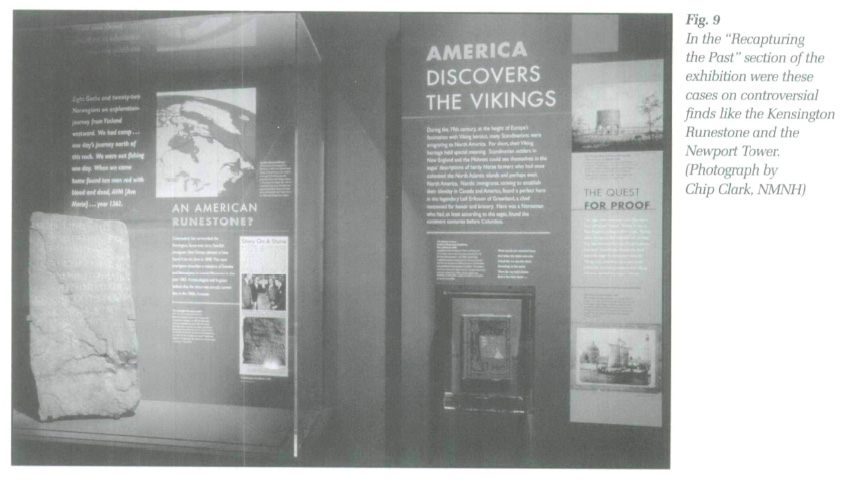 Display large image of Figure 9
Display large image of Figure 928 During our research into the available museum collections, I and the head curator, William Fitzhugh, had located two collections of Viking popular culture items, one at the Canadian Museum of Civilization (CMC) in Hull, Quebec, and one at the Statens Historiska Museum (SHM) in Stockholm, Sweden. These collections contain, among other things, many small Viking statues, pins with Viking inspired slogans, examples of horned helmets, and textiles and ceramics decorated with images of Vikings. Of this interesting array of goods, we had great difficulty making our selection. In most other cases, Fitzhugh and I made the selection of appropriate items with little advice from the designers. But in this case, we had a long discussion with the design team until we finally chose only hats with horns, since we reasoned this was the most recognized aspect of the Viking stereotype. Our educational goal for this case was to convince people that the Vikings did not wear horned helmets, and in so doing shake their faith in the stereotyped view of the Vikings, and in fact in the very idea that they knew what the name Viking meant.
29 The case contains crassly commercialized, absolutely contemporary modern Viking pop-culture items: six examples of horned helmets, a knock-off Minnesota Viking football helmet, and a cell from a Bugs Bunny cartoon (Fig. 10).The curatorial impetus for including all of these was simply to demonstrate visually what has been said in this paper and elsewhere: horned helmets are everywhere.
30 The horned helmets are displayed in this wall case in a colourful arrangement. A bronze coloured plastic helmet with large horns, and a blue baseball cap with cotton horns topped with bells on either side and the word "Sverge" (Sweden) written across the front were borrowed from SHM. From the CMC we borrowed a red plastic helmet with two small white plastic horns on either side, complete with two long synthetic blond braids — obviously a nod to the Brunnhilde image of the Viking warrior woman (and thus her horns were smaller!); a purple and bright blue dyed felt hat with matching horns on either side that looked like a medieval joker's hat; and a brand new Minnesota Vikings football helmet.
31 We also included in amongst these obviously mass-made plastic and synthetic homed helmets one very nicely made modern horned helmet out of all-natural materials, handmade by the Odin Forge in California, which we borrowed from a private individual.23 At first glance, it looks as if it could be a replica or a very well preserved helmet from the Viking Age. Although it draws upon the erroneous horned-helmet stereotype as much as the other pieces, it does not "read" as a piece of popular culture. I've since seen a photo of this type of helmet being worn at an NFL Viking football game, and wish I had incorporated the photo into the horned-helmet case to better emphasize the mass production of this piece.
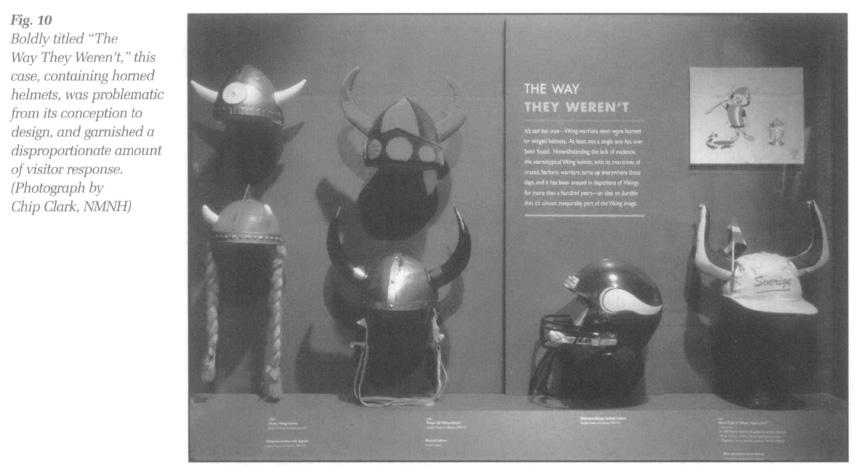 Display large image of Figure 10
Display large image of Figure 1032 The Bugs Bunny cartoon cell was from "What's Opera Doc?" which tells an extremely abridged version of the Wagner opera story. It features a pigtailed Bugs in drag as Brunnhilde, and Elmer Fudd as both his suitor and also his horned-helmeted hunter. The graphic designer, who had otherwise relied on our curatorial illustrative suggestions, felt that we should include something from this cartoon in the case. However, we had difficulty reaching someone at the Warner Brothers Studios to supply us with a photo, or rights to show a clip from the cartoon itself. We settled therefore for purchasing a framed "limited reproduction" cell at the local WB Store, which even had a built-in sound chip feature. It shows Elmer plunging his spear into Bugs' rabbit hole, while Bugs looks on, from a different hole, with concern. Though in hindsight it seems more appropriate to have the mass produced piece of true popular culture in our case,24 it did necessitate that this became a labeled object in the case rather than simply a graphic image.
33 This overview of the process by which the case was defined and the objects chosen illustrates how ad hoc and abnormal this case was. In fact, a sister exhibition developed by the Newfoundland Museum that was also funded by the Nordic Council of Ministers25 chose to not threaten the seriousness of their exhibition through the inclusion of a case on Viking popular culture. In Europe, Viking exhibitions at the state sponsored museums do not do this either, although a travelling exhibition developed by Carin Orrling (see below) does end with a short note on this idea. In general, it is not normal practice for curators and exhibit designers to place popular culture items in the midst of a traditional exhibition.
"The Way They Weren't"
34 How did visitors respond to this unusual case? Two written evaluations of visitor response to the exhibition Vikings: The North Atlantic Saga have been conducted, one at the opening installation in Washington, D.C., and one at the second installation in New York.26 Both used similar questions to make comparison possible, though the New York survey tracked visitor time in what they defined as forty-five exhibition components. The horned-helmet case, which was grouped with three other cases from "Recapturing the Past" as a single component, was stopped at by over seventy-five percent of the visitors to the exhibition. Only the re-created burial, which was low to the ground and one of the more accessible cases for children, was stopped at by more visitors (close to eighty percent). Both of these extremely high numbers confirm that visitors are prepared to commit more time to reading early in the exhibition, validating our decision to re-organize.
35 Interviews were conducted with visitors at the end of the exhibition, and one of the questions asked in both surveys was: "What surprised you in the exhibition?" Over two-thirds of the visitors to NMNH and half the visitors to AMNH said something surprised them, and of those, the fact that the Vikings did not wear horned helmets was cited as the most surprising piece of information. Some sample comments include: "There goes my image of 'horned' helmets" — male, age 70, at N.Y. venue; "I'm surprised that they addressed the stereotypes in the exhibit, they needed to be addressed" — young man at D.C. venue; "Vikings did not really wear those helmets" — male, age 19, N.Y. venue. Although the promotional material did sometimes mention this fact, the horned-helmet case was the only place in the exhibition itself where this message was conveyed. Since it was near the front of the exhibition, the fact that visitors recalled it upon exiting the exhibition suggests that message was well retained.
36 This retention was certainly due to the method by which it was conveyed. My personal observations from the hours I spent in the exhibition hall suggests why this case made an impression on the visitors. Often the first case people would see after walking past the introductory timeline and map, visitors approached this case as they would any other. Because they had come to an exhibition that had been heavily publicized, the visitors expect to see real, authentic,27 objects; many visitors did not comprehend immediately that these were modern popular culture items. As with any case, visitors would quickly look over the objects to determine for themselves the theme of the case, and only then if sufficiently interested would they read the text and labels.28 When they walked up to the case, their central impression of the Vikings as horned-helmeted warriors was instantly, and perhaps gratifyingly, reinforced. Every once in a while, the visitor would then quickly walk away.
37 But most stayed at the case long enough to notice something was strange about it. The helmets were plastic; was plastic around 1000 years ago? And some were brightly coloured; how could they survive so intact? And what is Bugs Bunny doing in a serious museum exhibit? Then they would see the Minnesota Vikings football helmet and know something was wrong.
38 With these questions raised, they would then turn to the text. The bold first line read, "The Way They Weren't," a very clever title developed by our talented script writer, Sue Voss. What made this so effective was that the tide relied upon a sense of irony. Beyond the unexpected word ending of the tide, there were also other layers of irony at work, for instance the realization that the most common symbol for the Viking was in fact historically incorrect. I would argue that it was the encounter with irony that made this case so memorable, and so effective at conveying its message.
39 Linda Hutcheon's review of the "Into the Heart of Africa" exhibit at the Royal Ontario Museum29 discussed the problems associated with using irony within a museum context, primarily because visitors have an expectation of straightforward, reliable information coming from museums as institutions. In that example, the irony depended upon a post-colonial critique of the museum and the state of Canada, and was less than successful. Vikings: The North Atlantic Saga on the other hand was one of the most successful exhibitions ever mounted by the NMNH, whether one evaluates it based on visitor understanding of the main points, number of visitors, or amount of media coverage. I believe this is because our use of irony was isolated and carefully framed. The unusual beginning to the exhibition created a rhetorical space separate from the main storyline that provided sufficient suspension of convention to allow for the inclusion of the even more unusual case of Viking popular culture items. Here irony served a well denned purpose and essentially drove the point home.
Collecting Popular Culture Items
40 Another somewhat ironic component of the horned-helmet case was that these obvious items of popular culture were treated just like all the other pieces in the show: they were in a locked case, with appropriate lighting and labelling. I recall one group that was touring the exhibit laughing at the case upon reading the object label "Canadian Museum of Civilization, 1999. 79.29" or "Museum of National Antiquities, Sweden." Their comment was meant to convey "these pieces were borrowed from a museum!" Perhaps they thought the object labels were actually a joke, much like the opening line of the case: the thought that museums had put effort into collecting these pieces was obviously amusing.
41 The collections from which these pieces were borrowed are in fact unusual. Both the Canadian Museum of Civilization and the Statens Historiska Museum have popular culture collections somewhat by accident. The collection at the CMC was recently bequeathed to them by the estate of Magnus Einarsson, an Icelandic-Canadian who was a curator in their folk-culture department. Manitoba, Canada, has the largest concentration of Icelanders outside of Iceland, and Einarsson explained that his interest in collecting popular culture items about the Vikings stemmed from his own cultural background.30 He had therefore purchased items he found representative of the genre, and had intended to one day mount a "Viking Kitsch" exhibition before his untimely death.
42 The collection at the SHM has been made by Carin Orrling, their editor-in-chief, who has curated exhibitions about the Vikings that have toured in South America as well as all over Europe. After working on an exhibition in 1972 documenting the Romantic Nationalist movement and one in 1996,31 which examined France's interest in the Vikings during the Romantic period, Orrling has continued to track the various material forms Vikings have taken in modern popular culture, though in a casual way by shopping in local stores wherever she might be travelling. She is presently working on a volume of her collection.
43 Both collections reflect the interest and taste of the collectors rather than a focused research effort, and they are somewhat marginalized within their museums. Some pieces in the collection are or were privately held by the curators, while other pieces belong to the museum. In the case of the CMC, our request to borrow these pieces for our exhibition was met with some surprise. From the humorous reaction the case itself elicited—which suggests confrontation with the unexpected — I surmise that the public is also somewhat uncomfortable with the idea that museums, especially honoured and authentic national museums, collect commercialized, commonplace, popular culture items.
44 This unease with "serious" museums having collections of popular kitsch items probably reflects that such collections are outside of the sphere of the museum, defined as the keeper of culturally important objects from the past. In a "natural" life of a group of objects, almost in a Darwinian model, time acts to wean down the group, and then the museum collector, perhaps 50 or 100 years later, acts deliberately upon that accidentally-formed group of contemporarily existing relics of the past. Through the agency of a museum, the life of an object chosen to become part of a museum collection is extended with appropriate care and conservation. What emerges is a small group of objects, miraculously "saved," that the public can then value as special, and unique. The role of the museum in saving these objects heightens its cultural worth. But the thought of curators in museums actively collecting these pieces available at any tourist shop is problematic and disconcerting for the public. Popular culture items are not special; they are commonplace, and therefore considered unworthy of the institutional efforts of a museum.
Contextualizing Objects
45 Exhibitions rely upon the interplay between object, text, graphics, as well as visual clues such as case design and lighting, to create meaning. In this delicate, unpredictable dance, the object is the centrepiece around which all else revolves. Nothing better convinces us of the foreignness of the past or of another culture than being confronted with an object whose meaning is not apparent to us.32 Objects can be strange to a museum visitor either because they come from a culture whose lifeways are different than their own, or because they were created in the past, or both. In modern western capitalist societies, there is an obsession with advancement and change, such that the once obvious purpose of objects made even fifty years ago quickly erodes. If the objects are unfamiliar to the visitor, the visitor must rely upon the museum to provide information from which they can glean meaning. The more unusual the material culture items being displayed are to the visitor's own life and experience, the more the museum has the ability to define those objects' meanings.
46 The trend in exhibitions at cultural museums especially has been towards greater care in "contextualizing" the objects by providing extensive historic and geographic background information through well written and organized text. Museum texts have become elaborated into diverse types to accommodate a hierarchy of information from the detailed to the general: simple object identifications; focus labels for groups of objects; case title and explanatory text; stand-alone text panels; and introductory texts throughout the exhibition. The latter three often utilize varying font sizes and bullet points to allow visitors who simply skim exhibition texts to quickly recognize the main point. Through the text, the curator and writer can choose what information the visitor has to build meaning, a power with which museum professionals often struggle.33
47 Almost every single piece in the exhibition Vikings: The North Atlantic Saga was both chronologically and geographically separate from the life experiences of the visitors. Because of this, we had great power to contextualize the objects and thus we were able to carefully define their meaning. Even in the "Recapturing the Past" section of the exhibition, there was need for the pieces to be explained and there was a straightforward curatorial message, much like the historical treatment given to Art Nouveau in the recent exhibition from the Victoria and Albert Museum and National Gallery of Art.34 These pieces were artistic, valuable, unique, and indisputably "worthy" of inclusion in a serious exhibition.
48 The only exception to this was the case of horned helmets. Unlike the other pieces in the exhibit, or even in the "Recapturing the Past" section, the horned-helmet case was full of extremely contemporary pieces. These objects, whose meaning rests solely within the context of the last fifty years, do not need to be explained for most museum visitors. In the quest to create a product which resonates with every single member of society (in hopes that all will buy it), popular material culture items, quickly mass produced and designed to be discarded, pair visually obvious shapes, colours, and materials with simplistic ideas. If they are, according to this rubric, made well, fully-functioning members of the target society have no need for the agency of the museum. In the case of Viking popular culture items, the meaning of horned helmets as iconographie of Vikings was entirely apparent immediately to the visitor. The visitor needed no explanation of what these items were meant to convey. Rather, the text for the horned-helmet case, unlike any other in the exhibition, assumed that the visitor would have specific foreknowledge of these objects. In fact, the irony of the text would not work if the visitor did not have the stereotyped view of the Vikings as horned-helmeted warriors imbedded in their consciousness.
49 In some ways, the immediate goal of undermining the Viking stereotype is less important than this more unintended outcome of including this case in the exhibition: the public became an integral part of the exhibit process. While museum professionals always acknowledge the role of the public in making meaning in an exhibit, it is often with some sense of displeasure or resignation. Certainly the plan of the exhibit as a whole sought to confine the public to a linear storyline, and to strictly define the objects' meaning through a text-heavy presentation. The horned-helmet case did the exact opposite: it welcomed the agency of the visitor. It opened up the museum process to the visitor; their knowledge of these horned helmets was extremely important for the case to be effective. Rather than assuming that the public had no knowledge, this case depended on them having a specific concept which by and large they did have.
Conclusion
50 The ubiquitous nature of the Viking stereotype, codified and commercialized through the material culture of plastic horned helmets, demonstrates how effective popular culture is at disseminating its ideas. Our case on horned helmets had to acknowledge and work within the realm of meaning established by pop culture, unlike every other case in the exhibition. On other levels as well, my experience in curating this case suggests that there is a perceived distinction between popular culture items and other material culture items. The effectiveness of this case, how memorable it was, and even our curatorial hesitancy to include it, all testify to a societal proclivity to place popular culture items in a separate category. Popular culture items are not seen as authentic35 subjects deserving of museum treatment; they may be humorous or interesting, but they are not considered educational in the same sense as other pieces of material culture.
51 The ironic aspects of the case — that these commonplace pop pieces were collected by professional scholars; that they were seamlessly included in a serious exhibition; and that the text relied on the visitor's knowledge to a great extent — all stem from this artificial distinction between "authentic" objects and popular culture items. The case would not have been ironic had there not been a transgression of boundaries, and in so doing, the case questioned the validity of that distinction. We seem to think ourselves, and our own material products, are set apart from those of other times and places. However, I would suggest that this is little more than modernist arrogance about the uniqueness of our times and our modes of production. Popular material culture items can be subjected to serious examination, and the process can be very revealing.
52 But in other ways, the case was very traditional. While subtly challenging the authority of the museum by suggesting curators are collecting commonplace items and by relying on the knowledge of the visitor to be effective, the case also strongly reaffirmed the authority of the museum by stating that the ubiquitous horned-helmet icon is historically incorrect. The ironic title was used as a vehicle to effective learning, rather than demonstrating a post-modernist hesitancy to make statements of fact. I feel that the case struck a pleasing balance between alienating and welcoming the visitor, and this allowed it to play an important role in the overall experience of the exhibition, and in the specific goal of debunking the Viking stereotype.36 But in a final piece of irony, I must admit that plastic horned helmets and swords have been the top-seller in each of the museum shops that have hosted the exhibition, mostly thanks to kids and teenage boys. It seems predestined that the horned-helmet icon will go the way of the Kensington Runestone, always to be embraced despite the best efforts of scholars, curators, and attentive museum goers.
I would like to thank Christopher Clarke and the reviewer for feedback on this submission, Saskia Wrausmann for research assistance, Johanne W. Gudbrandsen for perseverance in surveying visitors, Kym Rice for instruction in museum exhibition development, Keith Ward for theoretical insights and much patience, and the entire Viking exhibition team from whom I have learned so much: Robert Sullivan, Joe Madeira, Sue Voss, Richard Molinaroli, Mike Lawrence, Beth Miles, and especially William Fitzhugh, who also provided comments on earlier drafts.